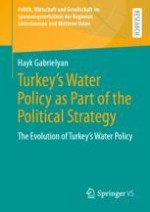2024 | OriginalPaper | Chapter
7. Water Projects and the Kurds of Turkey
Author : Hayk Gabrielyan
Published in: Turkey's Water Policy as Part of the Political Strategy
Publisher: Springer Fachmedien Wiesbaden
Activate our intelligent search to find suitable subject content or patents.
Select sections of text to find matching patents with Artificial Intelligence. powered by
Select sections of text to find additional relevant content using AI-assisted search. powered by
